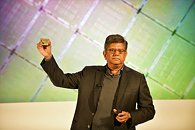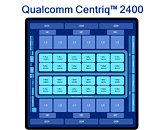Thursday, November 9th 2017
Qualcomm Starts Shipping 48-Core Centriq 2400 Processors
At a press conference held today in San Jose, Calif., Qualcomm Datacenter Technologies, Inc., a subsidiary of Qualcomm Incorporated (NASDAQ: QCOM), officially announced commercial shipment of the world's first and only 10 nanometer server processor series: the Qualcomm Centriq 2400 processor family. The Qualcomm Centriq 2400 processor family is the first high-performance Arm-based processor series designed to offer groundbreaking throughput performance for cloud workloads running in today's datacenters. Purpose built for cloud, the Qualcomm Centriq 2400 server processor family delivers exceptional performance-per-watt and performance-per dollar.
"Today's announcement is an important achievement and the culmination of more than four years of intense design, development and ecosystem enablement effort," said Anand Chandrasekher, senior vice president and general manager, Qualcomm Datacenter Technologies, Inc. "We have designed the most advanced Arm-based server processor in the world that delivers high performance coupled with the highest energy efficiency, enabling our customers to realize significant cost savings."Qualcomm Centriq 2400 Processor Family Technical Specs
The Qualcomm Centriq 2400 processor family is a single chip platform-level solution built using Samsung's 10 nanometer FinFET process with 18 billion transistors on only 398 mm². It contains up to 48 high-performance, 64-bit, single-thread cores, running at up to 2.6 GHz frequency. The cores are connected with a bi-directional segmented ring bus with 250GB/s of aggregate bandwidth to avoid performance bottlenecks under full load. To maximize performance under various use cases, the design has 512KB of shared L2 cache for every two cores, and 60 MB of unified L3 cache distributed on the die. It has 6 channels of DDR4 memory and can support up to 768 GB of total DRAM capacity with 32 PCIe Gen3 lanes and 6 PCIe controllers. The Qualcomm Centriq 2400 processor family also supports Arm's TrustZone secure operating environment, and supports hypervisors for virtualization. The Qualcomm Centriq 2400 is able to achieve exceptional performance, while consuming less than 120 watts.
With a list price of $1,995, the 48 core Qualcomm Centriq 2460 processor offers greater than 4X better performance per dollar and up to 45% better performance per watt versus Intel's highest-performance Skylake processor, the Intel Xeon Platinum 818.
A number of cloud service providers and technology companies participated in the launch event and demonstrated applications of an ARM-based datacenter running on the Qualcomm Centriq 2400 series. These included Alibaba, LinkedIn, Cloudflare, American Megatrends Inc., Arm, Cadence Design Systems, Canonical, Chelsio Communications, Excelero, Hewlett Packard Enterprise, Illumina, MariaDB, Mellanox, Microsoft Azure, MongoDB, Netronome, Packet, Red Hat, ScyllaDB, 6WIND, Samsung, Solarflare, Smartcore, SUSE, Synopsys, Uber, and Xilinx.
Optimized for common cloud workloads, the Qualcomm Centriq 2400 processor family has been designed to deliver throughput performance for highly threaded cloud native applications that are developed as micro-services and deployed for scale-out. Some of the key applications and use cases demonstrated today include:
"Today's announcement is an important achievement and the culmination of more than four years of intense design, development and ecosystem enablement effort," said Anand Chandrasekher, senior vice president and general manager, Qualcomm Datacenter Technologies, Inc. "We have designed the most advanced Arm-based server processor in the world that delivers high performance coupled with the highest energy efficiency, enabling our customers to realize significant cost savings."Qualcomm Centriq 2400 Processor Family Technical Specs
The Qualcomm Centriq 2400 processor family is a single chip platform-level solution built using Samsung's 10 nanometer FinFET process with 18 billion transistors on only 398 mm². It contains up to 48 high-performance, 64-bit, single-thread cores, running at up to 2.6 GHz frequency. The cores are connected with a bi-directional segmented ring bus with 250GB/s of aggregate bandwidth to avoid performance bottlenecks under full load. To maximize performance under various use cases, the design has 512KB of shared L2 cache for every two cores, and 60 MB of unified L3 cache distributed on the die. It has 6 channels of DDR4 memory and can support up to 768 GB of total DRAM capacity with 32 PCIe Gen3 lanes and 6 PCIe controllers. The Qualcomm Centriq 2400 processor family also supports Arm's TrustZone secure operating environment, and supports hypervisors for virtualization. The Qualcomm Centriq 2400 is able to achieve exceptional performance, while consuming less than 120 watts.
With a list price of $1,995, the 48 core Qualcomm Centriq 2460 processor offers greater than 4X better performance per dollar and up to 45% better performance per watt versus Intel's highest-performance Skylake processor, the Intel Xeon Platinum 818.
A number of cloud service providers and technology companies participated in the launch event and demonstrated applications of an ARM-based datacenter running on the Qualcomm Centriq 2400 series. These included Alibaba, LinkedIn, Cloudflare, American Megatrends Inc., Arm, Cadence Design Systems, Canonical, Chelsio Communications, Excelero, Hewlett Packard Enterprise, Illumina, MariaDB, Mellanox, Microsoft Azure, MongoDB, Netronome, Packet, Red Hat, ScyllaDB, 6WIND, Samsung, Solarflare, Smartcore, SUSE, Synopsys, Uber, and Xilinx.
Optimized for common cloud workloads, the Qualcomm Centriq 2400 processor family has been designed to deliver throughput performance for highly threaded cloud native applications that are developed as micro-services and deployed for scale-out. Some of the key applications and use cases demonstrated today include:
- Web front end with HipHop Virtual Machine
- NoSQL databases including MongoDB, Varnish, Scylladb
- Cloud orchestration and automation including Kubernetes, Docker, metal-as-a-service
- Data analytics including Apache Spark
- Deep learning inference
- Network function virtualization
- Video and image processing acceleration
- Multi-core electronic design automation
- High throughput compute bioinformatics
- Neural class networks
- OpenStack Platform
- Scaleout Server SAN with NVMe
- Server-based network offload



8 Comments on Qualcomm Starts Shipping 48-Core Centriq 2400 Processors
I thought Power and Sparc always kicked Intel's ass.